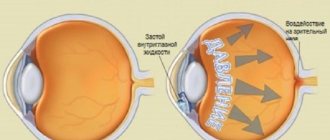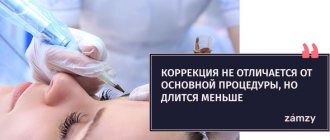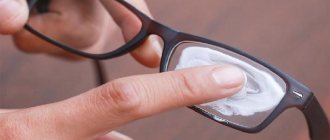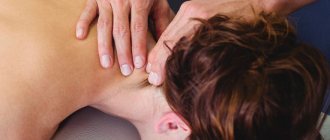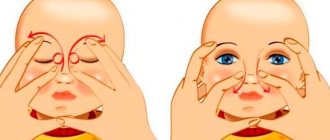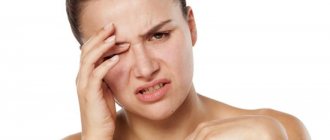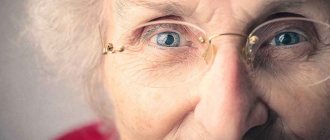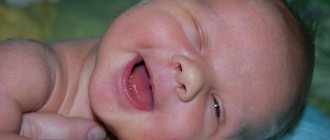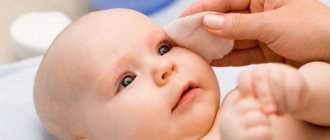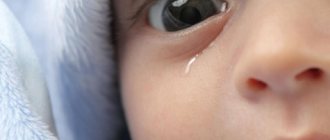Bacterial conjunctivitis of the eyes in a child
The cause of this type of disease is the contact of various pathogens on the mucous membrane of the organs of vision: gonococci, staphylococci, streptococci and other pathogenic microorganisms. This can happen when the baby bathes in insufficiently clean water or when rubbing the eyes
In this article
- Bacterial conjunctivitis of the eyes in a child
- Dacryocystitis of the eye in newborns
- Requirements for eye massage in newborns
- How to do eye massage for newborns correctly
- What to do if massage does not help with conjunctivitis and dacryocystitis
- Hygiene during treatment of dacryocystitis and conjunctivitis in children
with dirty hands, and there are also frequent cases of infection of the child at the time of birth if pathogens are present in the mother’s genitourinary area. In medical practice, there is a special term - ophthalmia of newborns. This is the name for inflammatory diseases of the visual organs after birth. At the same time, one should not confuse the regular accumulation of exudate in the inner corner of the baby’s eye, as often happens in the morning, with conjunctivitis of the eyes, the signs of which are quite pronounced: copious discharge of pus, increased lacrimation, itching, sticking of eyelashes in the morning, restless behavior of the child. Often, pathology develops in both eyes at once.
Why does the lacrimal sac become inflamed in newborns?
Inflammation in babies can develop as a result of several reasons:
- The tear duct becomes blocked with mucus or film.
- Features of the anatomical structure, the canal is too narrow.
- Hereditary predisposition.
- Anomalies in the structure or development of the nose and tear ducts.
- Infection in the eyes, inflammatory process.
The main symptoms of dacryocystitis in infants are increased lacrimation, redness of the eyes, swelling, discharge of pus and mucus.
Dacryocystitis of the eye in newborns
Another common eye pathology in infancy is dacryocystitis. This is an obstruction of the lacrimal canal, which causes stagnation of tears in it. There are two such tubules in total - on the side of the upper eyelid and the lower. 90% of the tear fluid flows through the lower canal into the nose, further moisturizing it from the inside. This is why when we cry and excessive lacrimation occurs, a runny nose occurs. Before a baby is born, its tear ducts have a thin membrane of fetal tissue. It protects the visual organs from amniotic fluid entering them. Usually this film breaks after birth, when the baby takes his first breath and his eyes begin to work normally. However, it happens that the film does not want to break, and then the normal outflow of tears is disrupted, infection occurs and dacryocystitis occurs - purulent inflammation of the lacrimal sac. Here are the main manifestations of this disease in a newborn:
- purulent discharge from the baby’s eyes in the second week of life;
- redness of the conjunctiva and skin at the inner corner of the eye;
- painful swelling, swelling of the eyelids;
- lacrimation;
- discharge of pus when pressing on the area of the lacrimal sac;
- eyelashes stuck together after sleep;
- temporary effect from the use of antibiotics and antiseptics.
Externally, the manifestations of the disease resemble eye conjunctivitis, and parents often practice independent treatment: washing the eyes with chamomile or tea infusion, instilling antibacterial drops. The symptoms disappear for a while and then recur. Since the main cause is not eliminated, the tear continues to stagnate, new bacteria enter the palpebral fissure and begin to multiply.
Every time a child develops purulent discharge from the eyes, there is no need to look for advice on the Internet; it is worth visiting an ophthalmologist for diagnosis. Only a specialist will determine what pathology caused the inflammation: conjunctivitis, dacryocystitis or something else. Standard treatment regimens for inflammatory eye diseases include rinsing the vision organs, administering drops and ointments. The doctor may also additionally prescribe an eye massage for clogged tear ducts to more effectively remove excess pus. It can be carried out by parents independently at home. Massage is an important procedure at the initial stage of treatment of eye conjunctivitis and dacryocystitis, as it affects the cause and is aimed at improving the patency of the lacrimal ducts.
Causes of poor lacrimal duct obstruction in infants
Under normal conditions, during blinking, the eyeball is moistened with tear fluid. This phenomenon prevents the eyeball from drying out and maintains normal vision. The tear collects in the lacrimal sac. It leaves the body through the nasolacrimal ducts.
If this channel is obstructed, the outflow of tear fluid is difficult or does not occur at all. A disease occurs - dacryocystitis (inflammatory disease of the lacrimal sac). Parents may not be aware of the presence of such a structural feature of the baby’s organ of vision and even give him antibiotics on their own. This cannot be done, because blockage of the tear duct is a genetically determined disease.
If the blockage of this part of the organ of vision is not treated, the newborn will develop chronic conjunctivitis. The pathology in some cases leads to loss of vision.
Obstruction of the lacrimal canal develops from the fact that during the prenatal period it is covered with a membrane. Because of this, amniotic fluid does not enter the canal. By the time of birth, the membrane dissolves with the first breath. This ensures the physiological outflow of tear fluid. But in some infants the membrane remains, causing obstruction of the lacrimal canal - dacryocystitis.
This disease also develops with obstruction of the lacrimal canal due to its true fusion. Often the outflow of tears becomes impossible due to infection.
Requirements for eye massage in newborns
Massaging with conjunctivitis or dacryocystitis requires compliance with certain rules so as not to harm the newborn. Be sure to cut long nails - they can injure the child's delicate skin or eyes. Wash and dry your hands thoroughly to avoid introducing another infection. You need to massage when the baby is in a calm, relaxed state, preferably five minutes after feeding. Do not carry out this procedure if the baby feels unwell or has a fever. Before you start massaging your eyes, rinse them and clean them of any traces of purulent discharge.
Take an antiseptic liquid - it can be a weak solution of furatsilin, a decoction of chamomile, or a weak infusion of tea. A cotton swab is moistened in the liquid and the pus is carefully removed, making movements from the outer edge of the eye to the inner, that is, from the temple to the nose. Use a separate cotton pad for each eye.
How to do eye massage for newborns correctly
The doctor will show you how to properly massage the lacrimal sac so that the process brings maximum benefit. You can also feel this pouch in yourself to better understand where it is. Place your index finger on the point in the inner corner of the eye where two canaliculi meet before entering the lacrimal sac. The pressure should not be too strong, but at the same time sufficient to expel the pus. From the found point, move from top to bottom towards the child’s nose, lightly pressing your finger. It is necessary to make approximately 6-10 such movements. In this case, pus should be released from the lacrimal sac - this is an indicator that the eye massage is carried out correctly. It is removed with a cotton swab and this continues until the contents of the canal stop coming out.
After completing the procedure, you need to rinse the eye with antiseptic solutions and then instill an antibiotic. This could be a solution of Levomycetin 0.25%, Vitabact or other means. Experts recommend performing eye massage for conjunctivitis in children or obstruction of the lacrimal duct for two weeks, while using antibacterial drops or ointments. Usually during this time the process normalizes and the tear begins to flow normally.
As a rule, the doctor’s prescription looks like this:
- eye massage - 4 times a day for 6-10 movements;
- washing with an antiseptic solution;
- "Levomycetin" 0.25% 1 drop * 4-5 times a day.
Treatment using massage techniques
The first symptoms of obstruction of the tear ducts should be a reason to contact an ophthalmologist. Only a doctor has the right to prescribe treatment that will be as safe as possible for the baby and will help quickly solve the problem of dacryocystitis.
Typically, therapy involves an integrated approach and the simultaneous use of massage and medications. In more complex cases and in later stages of the disease, the child may require probing or surgery.
The main purpose of massage for dacryocystitis is to remove the film or mucus plug that blocks the outflow of tears. The additional effect of massage is to reduce purulent discharge, activate lymphatic drainage, and improve nutrition of the visual organs.
Before starting the procedure, you need to visit an ophthalmologist and, if necessary, undergo tests. If a specialist recommends a massage, then at the appointment he will demonstrate the correct technique for performing it.
What to do if massage does not help with conjunctivitis and dacryocystitis
It happens that the prescribed treatment does not help, and conjunctivitis of the child’s eyes occurs again and again. The doctor prescribes various antibiotics, but after a short-term improvement the eye becomes inflamed again. In this case, an operation is prescribed - probing. It is performed under local anesthesia. The doctor inserts a probe into the nasolacrimal canal, breaking through the embryonic film, and then rinses it. It is necessary to restore the patency of the canal by the age of six months, otherwise phlegmon may develop in the future. In addition, the thin membrane begins to thicken over time, and it becomes more difficult to break through.
After the operation, a course of eye massage and special drops are prescribed to prevent the formation of adhesions, which can lead to relapse of the disease, again blocking the tear duct. If probing does not have the expected effect, an additional extended diagnosis of the child’s visual organs is carried out: perhaps the reason lies in an anomaly in the development of the nasolacrimal canal, a curvature of the nasal septum or other factors. In some cases, a child may need dacryocystorhinostomy - a complex operation that is performed only when he reaches the age of 5-6 years.
Hygiene during treatment of dacryocystitis and conjunctivitis in children
Try not to visit too crowded places with your child - it is better to conduct the course of therapy exclusively at home. It is advisable to change the diapers in your baby's crib every day. When administering drops, make sure that the tip of the bottle dispenser does not touch the mucous membrane and skin around the eyes, otherwise this may cause re-infection. Instill exactly as much medicine as prescribed by your doctor. After completing the procedure, you need to carefully blot the area around with a clean napkin and wash your hands again.
In advanced cases, eye conjunctivitis, especially bacterial, can lead to severe damage to the eye structures and loss of vision. If treatment of dacryocystitis is delayed, phlegmon of the lacrimal sac may occur. This disease is accompanied by high fever, the child becomes restless and cries. The result of the disease can be the formation of fistulas in the lacrimal canal. Carefully following all the doctor’s recommendations, as well as observing the rules of hygiene, will help eliminate the symptoms of inflammation as soon as possible.

